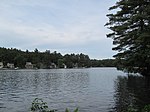Assabet River National Wildlife Refuge

The Assabet River National Wildlife Refuge (ARNWR; formerly referred to as the U.S. Army's Fort Devens-Sudbury Training Annex) is a 2,230-acre (9.0 km2) protected National Wildlife Refuge located approximately 25 miles (40 km) west of Boston and 4 miles (6.4 km) west of the Eastern Massachusetts National Wildlife Refuge Complex Headquarters, along the Assabet River. It is located in portions of the towns of Hudson, Maynard, Stow and Sudbury. The Assabet River National Wildlife Refuge consists of two separate pieces of land. The larger northern section is just north of Hudson Road, extending north to the Assabet River. The southern section is located to the south of Hudson Road. There is a visitor center located in the northern section on Winterberry Way.
Excerpt from the Wikipedia article Assabet River National Wildlife Refuge (License: CC BY-SA 3.0, Authors, Images).Assabet River National Wildlife Refuge
Blue,
Geographical coordinates (GPS) Address Nearby Places Show on map
Geographical coordinates (GPS)
| Latitude | Longitude |
|---|---|
| N 42.408333333333 ° | E -71.470555555556 ° |
Address
Assabet National Wildlife Refuge
Blue
01775
Massachusetts, United States
Open on Google Maps








